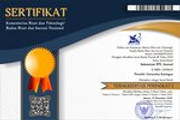METAFORA "CLOTHING" AS A NATURE OF NATURE IN READING BUTON PEOPLE IN THE TRANSLATION OF AJONGA YINDA MALUSA'S WORKS BY SYEKH HAJI ABDUL GANIU
Abstract
The purpose of this study is to describe the metaphor in the translation of Ajonga Yinda Malusa's manuscript by Sheikh Haji Abdul Ganiu. This research uses content analysis method (content analysis). By using Metaphor theory according to Lakoft & Johnson. As the results in this research are: the shame metaphor is a noble trait of clothing that never fades, the fear metaphor is a trait that requires trepidation Referring to something that is considered to bring disaster a metaphor full of nature with the meaning of loyalty and sincerity, the metaphor of shyness not just talking and from origin, everything that will be talked about and done is looking more for it.
Keywords: manuscripts; matafora; noble attributes.
Full Text:
PDFReferences
Altenbernd, L., & Lewis, L. L. (1966). A handbook for the study of poetry. Macmillan College.
Aninditha, G. B., & Utorodewo, F. N. (2014). Hang Tuah : Metafora Penokohan dalam hikayat Hang Tuah. Lib UI: Naskah RIngkas, 1–20.
Arifin, F. (2015). Metafora dalam Wayang Kulit Lakon Kilatbuana sebagai representasi kehidupan masyarakat Jawa dalam Wayang Kilit Lakon Kilatbuwana. In Electronic Theses & Dissertations. Universitas Gadjah Mada.
Astuti, S. (2012). Analisis semantis matafora dalam artikel majalah Der Spiegel. Universitas Indonesia.
Bell, P. (2001). Content analysis of visual images dalam Jewit, Carey, dan Van Leewen, Theo Handbook of Visual Analysis. London: Sage Publications.
Indonesian National Dictionary of the Ministry of National Education (2002). Kamus besar bahasa Indonesia (3rd ed.). Jakarta: Balai Pustaka.
Dilmayoni. (2015). Metafora dalam lirik lagu pada album Rilakan Nan Tamakan karya Agus Taher. UPT. Perpustakaan Unand.
Hartanto, W. (2018). Metafora kognitif tuturan penceramah dalam pengajian di wilayah Surakarta. Jurnal Kandai, 14(2), 181–196.
Haula, B., & Nur, T. (2019). Konseptualisasi metafora dalam rubrik opini kompas: Kajian semantik kognitif. Retorika: Jurnal Bahasa, Sastra, dan Pengajarannya, 12(1), 25–35.
Knowles, M. (2006). Rosamund Moon. Introducing Metaphor.
Lakoff, G., & Johnson, M. (1980). Conceptual metaphor in everyday language. The journal of Philosophy, 77(8), 453–486.
Mawarti, P. (2009). Kajian gaya bahasa metafora dalam novel Laskar Pelangi karya Andrea Hirata. Universitas Muhammadiyah Surakarta.
Niampe, L. (2018). Revolusi mental zaman kesultanan buton abad XIX (pesan-pesan peradaban untuk Indonesia dan dunia) (S. S. Dinar, Ed.). Kendari: Oceania Press.
Pradopo, R. D. (1990). Poetry study. Yogyakarta: Gadjah Mada University Press.
Rabani, L. O. (2019). Membaca masyarakat buton melalui tradisi lisan Kabanti Ajonga Yinda Malusa (Pakaian Yang Tidak luntur). Jurnal Sasdaya: Gadjah Mada Journal of Humanities, 3(1), 94–97.
Shintari, F., Effendy, C., & Syam, C. (2015). Penggunaan bahasa figuratif dalam kumpulan puisi bulan tertusuk lalang karya D. Zawawi Imron. Jurnal Pendidikan dan Pembelajaran Khatulistiwa, 5(1).
Subagiharti, H. (2015). Metafora melayu klasik dalam hikayat Abdullah. Universitas Sumatra Utara.
Yu, N. (1988). The contemporary theory of metaphor in Chinese: A perspective from Chinese. Amsterdam: John Benjamins.
DOI: https://doi.org/10.25134/ieflj.v8i2.6441
Refbacks
- There are currently no refbacks.

This work is licensed under a Creative Commons Attribution-ShareAlike 4.0 International License.

